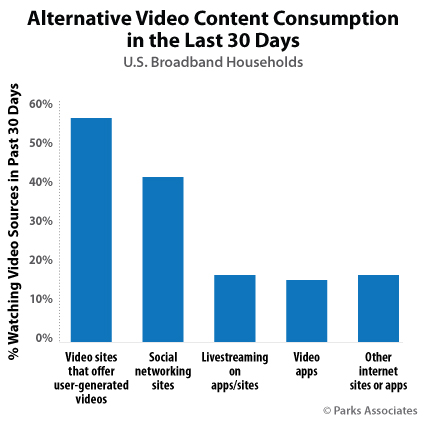U.S. broadband households watch two hours of alternative content on a computer each week
Thursday, July 12th, 2018
Consumers watch more than two hours of alternative video on a computer each week
- Research examines how alternative content is threatening pay TV
New video research from Parks Associates today reveals U.S. broadband households watch an average of two hours of alternative content on a computer each week from sources including Facebook, SnapChat, YouTube, Vimeo, and Dailymotion. “360 Deep Dive: Alternative Content Consumption” examines alternative content such as livestreaming, user-generated content, short-form videos, and web video series that are available via social networking, video sharing, or similar apps or sites. Nearly one-half of U.S. broadband households watch user-generated content on a monthly basis, and more than 10% watch livestreamed content.

“Alternative video is an important part of the video landscape, and it competes with other video options for a share of consumer attention,” said Brett Sappington, Senior Director of Research, Parks Associates. “Approximately one-half of households with a TV watch video from YouTube and similar sites on their TV set. In fact, more households watch online video from an app such as YouTube than watch video from a TV channel app.”
Parks Associates data about alternative content consumption shows that adoption of pay TV declines as the frequency of user-generated content consumption increases. This correlation poses a future threat to pay-TV providers as younger respondents are far more likely to watch user-generated content, which could potentially impact their future pay-TV habits and perspectives.
“Younger consumers are far more likely to create their own content as well as watch user-generated content,” Sappington said. “For these viewers, the creation of content is as much a part of the entertainment experience as is watching video. Increasingly, traditional content producers and service providers are leveraging alternative content in order to connect with audiences and draw viewers. Some are partnering with individual web celebrities and influencers who often have a disproportionately large influence on the user-generated side of the alternative content space.”
Additional data from the research reveals:
- At present, only 7% of U.S. broadband households watch sporting events via livestream.
- Consumers who view user-generated content are much more likely than those who never watch it to have an OTT service.
- Almost one-quarter of broadband households have posted videos to some type of content site or app within the last 30 days.
- Alternative content compromises more than two hours of online video watched weekly on a computer.
Latest News
- Nexxen empowers Australian advertisers using VIDAA ACR data
- TargetVideo integrates AI for video content categorization
- Meta opens Quest OS to third-party hardware makers
- Aferian to implement further cost reductions at Amino
- Paramount to exclusively represent SkyShowtime advertising sales
- Sky Sports Main Event latency reduced on Entertainment OS devices